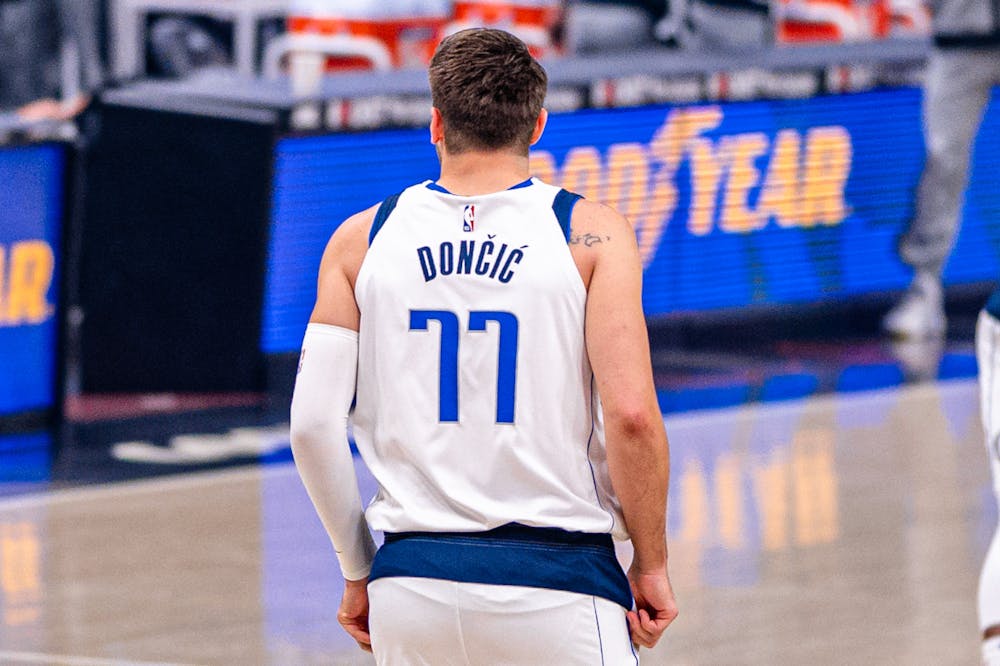Scoring in the NBA has reached a new high since the Wilt Chamberlain era. Just in the last week, Luka Dončić scored 73, Joel Embiid put up 70 and Devin Booker and Karl-Anthony Towns both posted 62 points on red-hot shooting nights. However, those efforts were not always enough: the Dallas Mavericks won by five, the Philadelphia 76ers won by 10, the Minnesota Timberwolves lost by three and the Phoenix Suns lost by two.
Perhaps close finishes are part of the recipe for high-scoring games; I will die on the hill that Klay Thompson could’ve reached Kobe’s 81 if Steve Kerr let him finish the Pacers game when he scored 60 in three quarters (29 minutes). Kobe played 42 minutes on his special night.
Those high-scoring games by star players are reflections of the current NBA, where the points per game across the league is the sixth highest in NBA history (only behind the early 1960s), and the offensive ratings are the highest in history since it was first tracked in 1973. On an individual level, there were 13 50-point games this season by eight different players and 26 games if extrapolated to a full 82-game season. This would be third in terms of most 50-point games in a single season, behind 1962-1963 (34 games, 30 from Wilt) and 1961-1962 (57 games, 45 from Wilt). It’s just not fair to compare statistics with Wilt.
Taking away the 1960s and the anomaly in Wilt Chamberlain, the past two NBA seasons saw some of the highest-scoring games in history. In the last year alone, there were four 70-point games from four different players (Dončić, Embiid, Damian Lillard and Donovan Mitchell). That’s four out of the nine 70-point games in the NBA that were not scored by Wilt. Last season, 2022-2023, also ranked high in points per game scored and offensive rating.
This frantic scoring spell also seems to propel a comeback from the big men. Giannis Antetokounmpo and Embiid have put up some of the best scoring performances this season and, combined with Nikola Jokic, have dominated the MVP conversation in the past five seasons. This puts an end to the small-ball NBA that we were familiar with in the 2010s, which was overrun by dominating guards like Stephen Curry, Russell Westbrook and James Harden and athletic Wings like LeBron James, Kevin Durant and Paul George. Nothing signifies the end of an era as much as Curry missing out on the All-Stars starting lineup this season.
However, the current big men are nothing like the bruising power forwards and centers that ruled the NBA in the 90s and early 2000s. The likes of Shaquille O’Neal, Hakeem Olajuwon and Karl Malone mostly operated in the restricted area, relying on their sheer size and strength, post-moves and shot-blocking abilities. It was nearly impossible to stop those dominant forces (unless you are Michael Jordan), and your best bet was to send them to the free-throw line.
That strategy will not work with the big men today. Free throws were a weakness in Giannis’s game — until he hit 17 of 19 free throws in Game 6 of the 2021 Finals. In fact, most of the big men are moving farther and farther from the hoop. In his career-high of 62 points, Towns hit 10 of his 15 threes. For reference, on his career night of 62 points, Stephen Curry only hit eight shots from beyond the arc. Seven-feet centers are not supposed to be able to shoot like that.
Embiid, who is averaging a scorching 36 points per game this season, can do a little bit of everything. He can back down almost any centers in the game, hunt for and hit his free throws and knock down his patented mid-range jumpers. Embiid’s 70-point night was a great display of his skillset — nine mid-range jumpers, 21 free throws and a three-pointer stacked on top. He can truly score from anywhere on the court.
This is without talking about the reigning Finals MVP, Nikola Jokic. While his scoring performances have not been as shiny as those of Embiid and Giannis, Jokic is quietly averaging a near triple-double and taking over the game whenever needed. His skill set is perhaps the most unconventional among the big men today. While he has an unstoppable post-game and a range extending beyond the three-point line, Jokic is most proficient in the passer’s spot at the top of the key. He is able to dissect the half-court game as beautifully as any point guard in the game, except at seven feet tall.
The future likely belongs to the big men as well. The two front runners in this season’s Rookie of the Year are 7’4 Victor Wembanyama and 7’1 Chet Holmgren. They stray even farther from the classic big men build of the NBA and are better categorized as unicorns. Moving like small forwards and dribbling like point guards, those two can dominate the paint for years to come, all while weighing 120 pounds less than Shaq. Those hot scoring performances might be a fluke, but these skilled big men are certainly here to stay.





